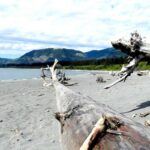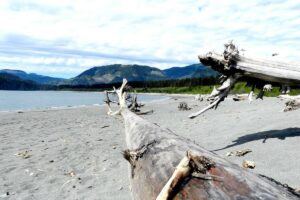The first of two homes on the verge of collapse on a stretch of the North Carolina Outer Banks prone to extreme erosion was demolished Wednesday by the National Park Service.
Funded by the Land and Water Conservation Fund, the service purchased the Rodanthe homes last month as a part of a pilot program to combat erosion on the Outer Banks, which are particularly vulnerable to climate change and sea level rise.
Five homes have collapsed in Rodanthe since 2020, with the most recent collapse in March 2023. Past collapses have caused highway closures, over 10 miles of debris and an expensive cleanup process — the service’s Cape Hatteras National Seashore program has stepped in multiple times to carry out additional cleanups and restore the beaches.
The removal of both threatened properties is contracted to cost $72,500 and the land will be open for public use after the beach is restored. Clean-up includes removal of the house pilings, as well as the houses’ septic tanks.
The beach house demolished Wednesday had formerly been owned by Eric Saks, who had named the building “Mermaid’s Kiss.” Saks, who had bought the property in 2021, was the one of the first homeowners to sell to the National Park Service.
“It’s important to us that this iconic house, which has been a part of our lives, is removed safely to avoid any harm to our precious coastal ecosystem,” Saks wrote in a post on Facebook. “While this decision came with a significant financial loss and a heavy heart, we believe it’s a step in the right direction for the environment we’re so passionate about protecting.”
David Hallac, superintendent of the Cape Hatteras National Seashore, helped to coordinate the sale of the homes and was present at the demolition Wednesday.
“It’s a pilot project, so something we’re trying out to mitigate the impacts of these threatened structures to the resources of Cape Hatteras seashore and our visitors,” said Hallac. “The work to remove the house today went very well. It was successful, it was done very safely, and they may actually take the second house down tomorrow. They’ve planned this very carefully in ensuring that this happens at low tide and that the wind and wave conditions are matching their criteria to get this done.”
According to Hallac, these threatened homes can have an impact on the seashore and visitors long before they fall into the sea.
“Pieces and parts can fall off the houses anytime because they’ve been hit by waves. The houses are in the middle of … a habitat that’s used by shorebirds and sea turtles. And even when the house is in reasonable condition, the septic systems, the septic tanks and the drain fields oftentimes get exposed or break open and cause public health threats,” he said.
Once the house collapses, it can create a large debris field that could take weeks, if not months, to clean up.
“This situation occurs in a much more controlled manner. The debris can be removed in a short period of time by professionals on the beach very quickly,” Hallas said.
Demolition of both homes and beach restoration are expected to take no more than 30 days. The two homes being demolished had been prioritized as they were closest to the ocean and had a high possibility of collapse.
One of the goals of the demolition is to evaluate the feasibility of a larger program addressing threatened oceanfront structures.
“We are interested in considering scaling the program up to acquire more homes and restore those beach areas,” said Hallac. “But we want to carry this pilot project out completely first, analyze how everything went, and learn what went well and what can be improved.”
Source : Courthouse News Service




































